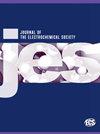Tuning of Band Gap of Cathode Li2NiPO4F by Replacing P to Nb and Forming Li2NiNbO4F for Application as 5 V Cathode in Lithium Ion Battery: A Density Functional Theory Study
IF 3.3
4区 工程技术
Q2 ELECTROCHEMISTRY
引用次数: 0
Abstract
Electrochemical properties of Li2NiPO4F were studied using density functional theory. The obtained voltage, electronic band gap, capacity (∼ for 2 Li+ extraction) and energy density are achieved as 5.33 V, 4.0 eV, 287.3 mAh g−1 and 1531.31 Wh kg−1, respectively. Although, the electrochemical properties of Li2NiPO4F are promising, large electronic band gap would certainly pose a limitation for its commercial application. Nb is a transition metal and its electronegativity is 1.6 which is less than the electronegativity of 2.19 for P. This implies, less operating voltage would be obtained if we replace P in Li2NiPO4F by Nb to form Li2NiNbO4F. However, electronic configuration of Nb is [Kr] 4d45 s1 and the valance state of Nb in Li2NiNbO4F is +5, which in turn specify that, localized Nb d states will reside in conduction band of Li2NiNbO4F and hence the electronic band-gap would be less owing to this localized Nb-d states. Our speculation gets verified by the calculated properties of Li2NiNbO4F obtained through DFT as follows; Voltage, electronic band gap, capacity (∼ for 2 Li+ extraction) and energy density achieved, respectively, are 5.01 V, 3.64 eV (less than LiFePO4), 215.71 mAh g−1, 1080.71 Wh kg−1. Lower electronic band gap of Li2NiNbO4F makes it an alternative to Li2NiPO4F.通过将 P 替换为 Nb 并形成 Li2NiNbO4F 阴极来调整 Li2NiPO4F 的带隙,以用作锂离子电池中的 5 V 正极:密度泛函理论研究
利用密度泛函理论研究了 Li2NiPO4F 的电化学特性。得到的电压、电子带隙、容量(∼ 2 Li+萃取)和能量密度分别为 5.33 V、4.0 eV、287.3 mAh g-1 和 1531.31 Wh kg-1。虽然 Li2NiPO4F 的电化学特性很有前景,但较大的电子带隙肯定会限制其商业应用。铌是一种过渡金属,其电负性为 1.6,小于 P 的电负性 2.19,这意味着如果用铌取代 Li2NiPO4F 中的 P,形成 Li2NiNbO4F,将获得较低的工作电压。然而,铌的电子构型为[Kr] 4d45 s1,而铌在 Li2NiNbO4F 中的价态为 +5,这反过来又说明,局部的铌 d 态将驻留在 Li2NiNbO4F 的导带中,因此电子带隙会因局部的铌 d 态而减小。通过 DFT 计算得到的 Li2NiNbO4F 的特性验证了我们的推测:电压、电子带隙、容量(∼ 2 Li+萃取)和能量密度分别为 5.01 V、3.64 eV(低于 LiFePO4)、215.71 mAh g-1、1080.71 Wh kg-1。Li2NiNbO4F 较低的电子带隙使其成为 Li2NiPO4F 的替代品。
本文章由计算机程序翻译,如有差异,请以英文原文为准。
求助全文
约1分钟内获得全文
求助全文
来源期刊
CiteScore
7.20
自引率
12.80%
发文量
1369
审稿时长
1.5 months
期刊介绍:
The Journal of The Electrochemical Society (JES) is the leader in the field of solid-state and electrochemical science and technology. This peer-reviewed journal publishes an average of 450 pages of 70 articles each month. Articles are posted online, with a monthly paper edition following electronic publication. The ECS membership benefits package includes access to the electronic edition of this journal.

 求助内容:
求助内容: 应助结果提醒方式:
应助结果提醒方式:


